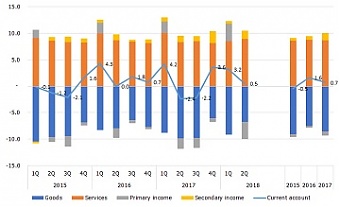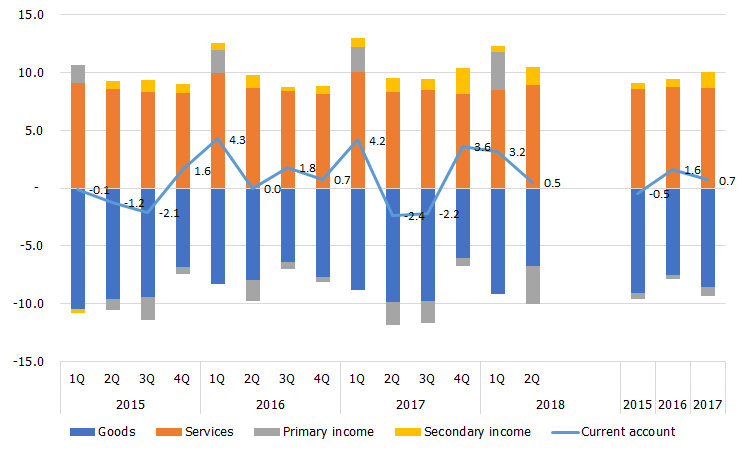Analytics, Direct Speech, GDP, Latvia
International Internet Magazine. Baltic States news & analytics
Thursday, 18.04.2024, 15:28
The current account surplus stood at 0.5% of GDP in the second quarter
 Print version
Print version |
|---|
The current account recorded a surplus also in the second quarter of 2018. This was driven by a stronger increase in exports of goods and services and concurrent weaker import growth. The deficit of the primary income account resulted from a rise in dividends paid to foreign investors. This upward path could be associated with the new corporate income tax regulation. Overall, the current account surplus amounted to 35.4 mln euro or 0.5% of gross domestic product (GDP) in the second quarter of 2018.
Main components of the current account (% of GDP)

The second quarter saw Latvia's exports of goods expand strongly, following a slower pace of growth observed in the first quarter (annual growth of 11.3%). The figures for the first half of 2018 also show an increase (8.2%). The good performance was largely the result of an expansion of exports to the major partner countries, such as the United Kingdom, Lithuania, Germany and Sweden. This reflects sustainable and favourable external demand in the region. Meanwhile, the trend in imports of goods observed in the first quarter remained unchanged. The annual growth rate amounted only to 4.3% on account of the high base achieved in the previous year (purchase of aircraft).
In the second quarter, exports of services, like those of goods, also expanded noticeably, reaching 10.6%. Looking at the growth experienced in the first half of 2018, it is obvious that the pace of exports of services grew by 6.1%, largely due to higher spending of foreign visitors and an increase in exports of IT and computer services. Both the events related to the celebration of Latvia's centenary and the favourable weather conditions contributed to the spending by foreign visitors in the second quarter. The expansion of exports of construction services is also worth mentioning. The above exports have followed an upward trajectory year-on-year, even despite the strong demand on the domestic market. The second quarter witnessed a slower rate of increase in imports of services (4.9%), while the annual growth rate stood at 8.5% in the first half of the year as a whole. Transportation, IT and computer services were the most imported ones.
The results of the second quarter suggest that favourable external demand still persists. However, looking ahead, there are signs of precaution stemming from global uncertainty risks, such as Brexit, the likelihood of trade war, etc.
The financial transactions data of the balance of payments show that the second quarter witnessed a continued deceleration in both assets and liabilities. The largest flows relate to a decline in deposits by foreign customers. To ensure disbursement of deposits, this decrease was offset by generating funds from selling other assets abroad. The securities purchased under the expanded asset purchase programme somewhat increased the international assets position.
The overall foreign direct investment amounted to nearly 23 mln euro. Its largest inflows were registered from Sweden, Estonia and Lithuania. At the sectoral level, the largest foreign direct investment inflows were seen by the manufacturing, financial and trade sectors.








 «The Baltic Course» Is Sold and Stays in Business!
«The Baltic Course» Is Sold and Stays in Business!

